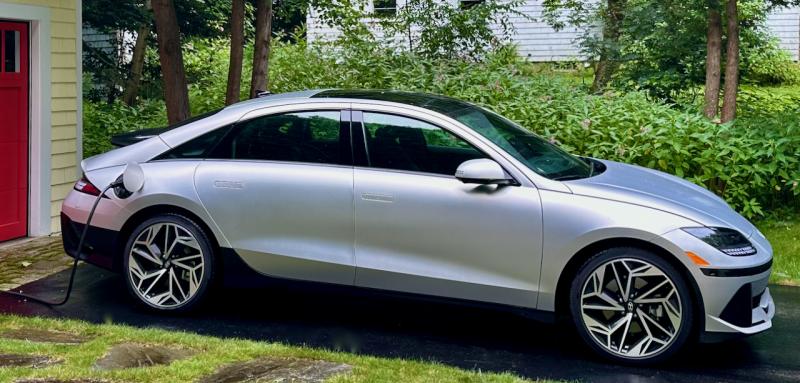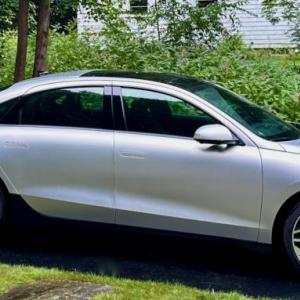Hyundai Ioniq 6 Limited (Long Range AWD)
 Electricity and water don’t mix well, or mix all too well, so I have qualms about recharging outdoors in the rain, but every EV and plug-in hybrid can cope with this. (One of my own cars is in that bay of the garage, so I can’t roll this one inside.) The Ioniq 6 hasn’t changed since 2023; it remains a smooth and stylish sedan that in AWD configuration offers tremendous—or sedate—performance.
Electricity and water don’t mix well, or mix all too well, so I have qualms about recharging outdoors in the rain, but every EV and plug-in hybrid can cope with this. (One of my own cars is in that bay of the garage, so I can’t roll this one inside.) The Ioniq 6 hasn’t changed since 2023; it remains a smooth and stylish sedan that in AWD configuration offers tremendous—or sedate—performance.
 Electricity and water don’t mix well, or mix all too well, so I have qualms about recharging outdoors in the rain, but every EV and plug-in hybrid can cope with this. (One of my own cars is in that bay of the garage, so I can’t roll this one inside.) The Ioniq 6 hasn’t changed since 2023; it remains a smooth and stylish sedan that in AWD configuration offers tremendous—or sedate—performance.
Electricity and water don’t mix well, or mix all too well, so I have qualms about recharging outdoors in the rain, but every EV and plug-in hybrid can cope with this. (One of my own cars is in that bay of the garage, so I can’t roll this one inside.) The Ioniq 6 hasn’t changed since 2023; it remains a smooth and stylish sedan that in AWD configuration offers tremendous—or sedate—performance.
Some of my favorite cars now are battery-powered. Come to think of it, I have yet to drive an EV of any make that didn’t impress in one way or another. Or in several ways: throttle response, acceleration, one-pedal driving, instrumentation, skipping gas stations and tune-ups and oil changes... all of it. The technological whiz-bangery of this new type of motor vehicle appeals to my inner car nerd.
Today’s EVs aren’t perfect, but no complex technology is ever completely perfected—there are always improvements waiting in the wings. I often get press releases about breakthroughs in some aspect of EV technology, and I can predict with confidence that the 2034 Ioniq 6 is going to leave this ’24 model behind—it will weigh 1,000 pounds less and/or cost $1,000 less and/or go 800 miles on a charge and/or recharge itself from the sun or the atmosphere or wires buried in my garage or the roadway.
(This is true for fossil fuel-powered vehicles too. With EVs breathing down their necks, internal-combustion engines are still becoming lighter and more powerful and efficient—just not as quickly as in days of yore because internal combustion may be nearing its technological plateau while EV systems are still on the steep part of the development curve.)
There’s little if any difference between the 2023 top-trim-level Ioniq 6 (reviewed here last October) and this similar ’24 model, but this one does cost slightly less: $56,010 compared to last year’s $57,425. Either price seems reasonable for a well-built and well-equipped, quiet and comfortable all-wheel-drive sedan that offers 320 horsepower and an astonishing 446 pound-feet of torque. An entry-level Ioniq 6 with rear-wheel drive and 149 horsepower also costs slightly less than last year, starting at $38,650.
A top-up from my home charger puts a computer-indicated 277 miles in the Ioniq 6 Limited’s long-range “tank,” but in my experience the actual mileage is slightly less (and in cold weather would be less yet). These days, I very rarely drive more than about 100 miles at a whack, so this isn’t a concern for me. But range anxiety is an issue in the EV market, and range is the No. 1 challenge for EV makers.
However, the question isn’t only how far an electric vehicle can go before the batteries need topping up; it’s also where is the next recharging station, is it working properly and how many cars are in line ahead of me? Even in metro Portland, never mind rural Maine, these are bona fide concerns. Fortunately, as part of our environmental goals, the state is working to ease these bottlenecks.
As for how long it takes to recharge... this is a function of the power source, the car’s charging capacity and the size of its battery bank. I refer back to paragraph #2: the technology is improving quickly.
And, finally, if we all drive EVs, will there be enough electricity to go around? It’s a reasonable question, as demand for air-conditioning skyrockets and we move away from oil- and gas-fired home heat to electric heat pumps, and as crypto-currency, artificial intelligence and other massive consumers of power come on line. But it’s good that no one’s building new coal-fired generating plants, hydro dams or nuclear reactors. Isn’t it?
According to the U.S. Energy Administration, this year our country will add 55% more power capacity than it did last year—62.8 gigawatts, the largest year-over-year increase since 2003. Furthermore, 96% of it will be renewable and/or carbon-free; the largest portion, 58%, will be solar power. Only 4% will come from fossil fuel—natural gas, not coal. Critically, the forecast also includes a 23% jump in battery-storage capacity. (California currently produces more solar power than it can use and has to waste the excess because it can’t be stored till it’s needed.) In fact, the largest such battery is slated to be built here in Maine—the old Lincoln Paper and Tissue mill will be redeveloped to capture up to 85 megawatts of wind and solar energy and release it back into the grid at night and on windless days.
Right, back to the Ioniq 6. Last Saturday, I drove about 30 miles of narrow, forested back roads with sharp changes in elevation, aka hills, and short straights linked by dozens of tight left- and right-hand bends. In Sport and One-Pedal drive modes, and with its low center of gravity, linear steering and excellent balance, the Ioniq 6 AWD could maintain a motion sickness-inducing, point-and-shoot pace that very few road-legal sports cars can match. For information on the more sedate aspects of this car, again I refer you back to October 2023.
Next week: Lexus LS500






















